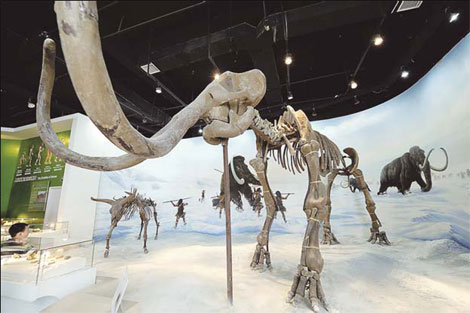Where dinosaurs once roamed
 |
|
Replicas of dinosaur skeletons on display at a Liaoning museum. Zhao Jingdong / Asia News Photo |
Five-year-old Zhang Zihao is a big dinosaur fan. The kindergartner owns dinosaur books, miniature dinosaur models, and in the past year and a half has already dragged his mother four times to the Bird Fossils National Geopark in their home city of Chaoyang.
"His favorite exhibits are the life-size dinosaur models," Zhang's mother Zhu Yan says.
A three-story, first-rate fossil museum in a third-tier Chinese city is quite remarkable. But more so is the ground underneath it.
Chaoyang's Sihetun village, an hour by car from the city center, yielded one of mankind's most significant fossil finds - the sinosauropteryx, the first feathered dinosaur ever unearthed, which lived during the late Jurassic Period, 160-145 million years ago.
Its discovery was further proof that birds evolved from dinosaurs, and at the same time put into question the legitimacy of the long-established "earliest bird", the archaeopteryx.
"A lot of the uniquely avian features that archaeopteryx has have turned out to be not so unique after all," Lawrence Witmer, a paleontologist at Ohio University, wrote in the July 27 issue of the scientific journal Nature. "Perhaps the time has come to finally accept that archaeopteryx was just another small, feathered, bird-like theropod fluttering around in the Jurassic."
The Bird Fossils Geopark stands beside another excavation site, in Shangheshou village, a 15-minute drive from downtown. Steps lead to the bottom of the pit, 4.5 meters below ground, where visitors can see through protective glass the fish, birds and plants that thrived here 100 million years ago. The pit also shows the layers of volcanic lava that obliterated these creatures.
The 2,300-square-meter geopark museum, opened in 2007, is a wonderful showcase of the prehistoric world. Its collection includes dinosaur skeletons, fossil trees, a cross-section of a lake showing 128 types of fish, the fossil of a prehistoric turtle whose tail is as long as its body, water lizards, insects and shells.
Naturally, the museum's most prized exhibit is the sinosauropteryx, reproductions of which are displayed on the second floor, beside fossils of other feathered dinosaurs unearthed in Chaoyang, in western Liaoning province. (The original fossils are kept in Beijing and Nanjing.) There's also the achaefructaceae, another local find, which the geopark is hailing as the world's "first flower".
One exhibit not to miss are two psittacosaurus, or parrot-mouthed dinosaurs, caught in the act of love.
"They met, fell in love, then the volcano erupted," Song Shuang, a museum tour guide, says. "How often do you see something like this?"
The discovery of paleontological gems in Chaoyang has spawned a vibrant, local fossil industry.
Downtown, between the North and South pagodas, where relics of the Sakyamuni Buddha and his teacher were discovered at the turn of the century, is Murong Street, more popularly known as Fossil Street.
The 800-meter-long street is lined with shops offering "second-class" fossils, merchandise mimicking some of the museum's contents. For 5 yuan (78 US cents), you can take home a framed, mirror-image pair of tiny fossil fish embedded in slate, or a carving made from fossil tree for 78,000 yuan ($12,244).
The fossils, say shopkeepers, are supplied by local prospectors - it was a farmer who unearthed the first sinosauropteryx fossil in August 1996, while digging to plant trees. Obviously, the locals have learned that there's more than one type of gem buried under their feet.
















